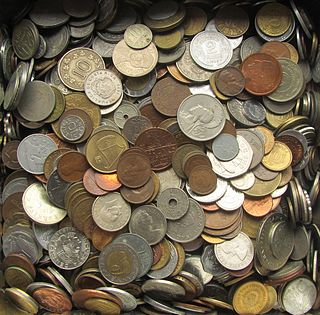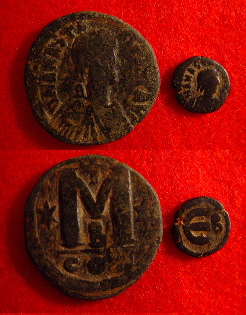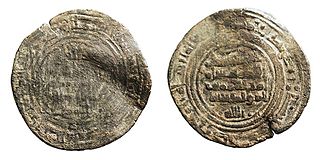
The follis (plural folles; Italian : follaro, Arabic : فلس, Fels) was a type of coin in the Roman and Byzantine traditions.

The follis (plural folles; Italian : follaro, Arabic : فلس, Fels) was a type of coin in the Roman and Byzantine traditions.

The term follis is used for a large bronze Roman coin denomination introduced by Diocletian in about 294. The term "nummus" is now thought to be the actual ancient term, but usage of "nummus" has not caught on. [1] At first the follis weighed about 10 grams and was about 4% silver, with a thin layer of silver on the surface. Over the next decades it declined both in size and in silver content.
The word follis means bag (usually made of leather) in Latin, and there is evidence that this term was used in antiquity for a sealed bag containing a specific amount of coinage. It has also been suggested that the coin was named Follis because of the ancient Greek word "φολίς" meaning a thin layer of metal (cf. Latin folium , "leaf") which covers the surface of various objects, since originally, this coin had a thin layer of silver on top. The 'follis' of Diocletian, despite efforts to enforce prices with the Edict on Maximum Prices (301), was revalued and reduced as time passed. By the time of Constantine the Great, it was smaller and barely contained any silver. A series of Constantinian bronzes was introduced in the mid-4th century, although the specific denominations are unclear and debated by historians and numismatists. They are referred to as AE1, AE2, AE3 and AE4, with the first being the largest (near 27 mm) and the last the smallest (averaging 15 mm) in diameter. Namely:
| AE1 | AE2 | AE3 | AE4 |
|---|---|---|---|
| over 25 mm | 21 – 25 mm | 17 – 21 mm | under 17 mm |
Large hoards of folles have been discovered all across the Roman empire. For example, in Seaton Down, Devon, England, near the site of a second- to third-century Roman villa and fortifications, 22,888 folles were found in 2013. [2] Fourth century folles represent the largest category of coin finds in the United Kingdom. [3] Between 30,000 and 50,000 exceptionally well-preserved folles from the first half of the fourth century were discovered in the sea near the north-east shore of Sardinia in 2023. [4]


The term "follis" is used for the large bronze coin denomination (40 nummi) introduced in 498, with the coinage reform of Anastasius, which included a series of bronze denominations with their values marked in Greek numerals.
The fals (a corruption of follis) was a bronze coin issued by the Umayyad and Abbasid caliphates beginning in the late 8th century, initially as imitations of the Byzantine follis.

A coin is a small object, usually round and flat, used primarily as a medium of exchange or legal tender. They are standardized in weight, and produced in large quantities at a mint in order to facilitate trade. They are most often issued by a government. Coins often have images, numerals, or text on them. The faces of coins or medals are sometimes called the obverse and the reverse, referring to the front and back sides, respectively. The obverse of a coin is commonly called heads, because it often depicts the head of a prominent person, and the reverse is known as tails.

The denarius was the standard Roman silver coin from its introduction in the Second Punic War c. 211 BC to the reign of Gordian III, when it was gradually replaced by the antoninianus. It continued to be minted in very small quantities, likely for ceremonial purposes, until and through the Tetrarchy (293–313).

The as, occasionally assarius, was a bronze, and later copper, coin used during the Roman Republic and Roman Empire.

Roman currency for most of Roman history consisted of gold, silver, bronze, orichalcum and copper coinage. From its introduction during the Republic, in the third century BC, through Imperial times, Roman currency saw many changes in form, denomination, and composition. A feature was the inflationary debasement and replacement of coins over the centuries. Notable examples of this followed the reforms of Diocletian. This trend continued with Byzantine currency.
Byzantine currency, money used in the Eastern Roman Empire after the fall of the West, consisted of mainly two types of coins: gold solidi and hyperpyra and a variety of clearly valued bronze coins. By the 15th century, the currency was issued only in debased silver stavrata and minor copper coins with no gold issue. The Byzantine Empire established and operated several mints throughout its history. Aside from the main metropolitan mint in the capital, Constantinople, a varying number of provincial mints were also established in other urban centres, especially during the 6th century.

The history of coins stretches back to the first millennium BC/BCE. Notable early examples of coins include the Lydian Lion coins, Persian daric and siglos, Tong Bei, the dirham and gold dinar.

The history of ancient Greek coinage can be divided into four periods: the Archaic, the Classical, the Hellenistic and the Roman. The Archaic period extends from the introduction of coinage to the Greek world during the 7th century BC until the Persian Wars in about 480 BC. The Classical period then began, and lasted until the conquests of Alexander the Great in about 330 BC, which began the Hellenistic period, extending until the Roman absorption of the Greek world in the 1st century BC. The Greek cities continued to produce their own coins for several more centuries under Roman rule. The coins produced during this period are called Roman provincial coins or Greek Imperial Coins.

The solidus or nomisma was a highly pure gold coin issued in the Later Roman Empire and Byzantine Empire. The early 4th century saw the solidus introduced in mintage as a successor to the aureus, which was permanently replaced thereafter by the new coin, whose weight of about 4.5 grams remained relatively constant for seven centuries.

The siliqua is the modern name—given without any ancient evidence to confirm the designation—to small, thin, Roman silver coins produced in the 4th century and later. When the coins were in circulation, the Latin word siliqua was a unit of weight or value defined by one late Roman writer as one twenty-fourth of a Roman solidus.
"Siliqua vicesima quarta pars solidi est, ab arbore, cuius semen est, vocabulum tenens."
A siliqua is one twenty-fourth of a solidus, having its name from the tree of which it is the seed.

The Edict on Maximum Prices was issued in 301 AD by Diocletian. The document denounces greed and sets maximum prices and wages for all important articles and services.

The argenteus was a silver coin produced by the Roman Empire from the time of Diocletian's coinage reform in AD 294 to ca. AD 310. It was of similar weight and fineness to the denarius of the time of Nero. The coin was produced at a theoretical weight of 1/96th of a Roman pound, as indicated by the Roman numeral XCVI on the coin's reverse.
Roman Republican currency is the coinage struck by the various magistrates of the Roman Republic, to be used as legal tender. In modern times, the abbreviation RRC, "Roman Republican Coinage" originally the name of a reference work on the topic by Michael H. Crawford, has come to be used as an identifying tag for coins assigned a number in that work, such as RRC 367.

Silver coins are one of the oldest mass-produced form of coinage. Silver has been used as a coinage metal since the times of the Greeks; their silver drachmas were popular trade coins. The ancient Persians used silver coins between 612–330 BC. Before 1797, British pennies were made of silver.

The gold dinar is an Islamic medieval gold coin first issued in AH 77 (696–697 CE) by Caliph Abd al-Malik ibn Marwan. The weight of the dinar is 1 mithqal.

Nummus is a Latin word for various coins that was borrowed from Doric Greek noummos. Originally referring to a specific style of coin used in Greek-speaking Southern Italy, the term nummus came to be used by the Late Republic for all coins generally and particularly as a synonym for the sestertius, then the standard unit of Roman accounting, and then in Late Antiquity as the formal name of the follis. It was used in this general sense in Early Modern English but is most commonly employed by modern numismatists as a catchall term for various low-value copper coins issued by the Roman and Byzantine empires during Late Antiquity.

Billon is an alloy of a precious metal with a majority base metal content. It is used chiefly for making coins, medals, and token coins.

In numismatics, the term Constantinian bronzes denotes the series of bronze coins issued in the Roman Empire in the middle of the 4th century. The specific denominations are unclear and debated by historians and numismatists. They are referred to as AE1, AE2, AE3, and AE4, with the former being the largest and the latter the smallest in diameter:

Tarsus Museum is an archaeology and ethnography museum in Tarsus, Mersin Province, in southern Turkey.
Carthaginian or Punic currency refers to the coins of ancient Carthage, a Phoenician city-state located near present-day Tunis, Tunisia. Between the late fifth century BC and its destruction in 146 BC, Carthage produced a wide range of coinage in gold, electrum, silver, billon, and bronze. The base denomination was the shekel, probably pronounced in Punic. Only a minority of Carthaginian coinage was produced or used in North Africa. Instead, the majority derive from Carthage's holdings in Sardinia and western Sicily.